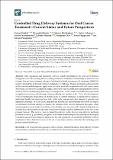Controlled drug delivery systems for oral cancer treatment--current status and future perspectives
Author(s)
Koutsopoulos, Sotirios
Downloadpharmaceutics-11-00302-v2.pdf (2.115Mb)
Publisher with Creative Commons License
Publisher with Creative Commons License
Creative Commons Attribution
Terms of use
Metadata
Show full item recordAbstract
Oral squamous cell carcinoma (OSCC), which encompasses the oral cavity-derived malignancies, is a devastating disease causing substantial morbidity and mortality in both men and women. It is the most common subtype of the head and neck squamous cell carcinoma (HNSCC), which is ranked the sixth most common malignancy worldwide. Despite promising advancements in the conventional therapeutic approaches currently available for patients with oral cancer, many drawbacks are still to be addressed; surgical resection leads to permanent disfigurement, altered sense of self and debilitating physiological consequences, while chemo- and radio-therapies result in significant toxicities, all affecting patient wellbeing and quality of life. Thus, the development of novel therapeutic approaches or modifications of current strategies is paramount to improve individual health outcomes and survival, while early tumour detection remains a priority and significant challenge. In recent years, drug delivery systems and chronotherapy have been developed as alternative methods aiming to enhance the benefits of the current anticancer therapies, while minimizing their undesirable toxic effects on the healthy non-cancerous cells. Targeted drug delivery systems have the potential to increase drug bioavailability and bio-distribution at the site of the primary tumour. This review confers current knowledge on the diverse drug delivery methods, potential carriers (e.g., polymeric, inorganic, and combinational nanoparticles; nanolipids; hydrogels; exosomes) and anticancer targeted approaches for oral squamous cell carcinoma treatment, with an emphasis on their clinical relevance in the era of precision medicine, circadian chronobiology and patient-centred health care. ©2019 Keywords: oral, head and neck squamous cell carcinoma; targeted therapies; drug delivery systems; nanoparticles; controlled drug delivery; circadian clock; chronotherapy; precision medicine
Date issued
2019-06-30Department
Massachusetts Institute of Technology. Center for Biomedical EngineeringJournal
Pharmaceutics
Publisher
Multidisciplinary Digital Publishing Institute
Citation
Ketabat, Farinaz, et al., "Controlled drug delivery systems for oral cancer treatment--current status and future perspectives." Pharmaceutics 11, 7 (June 2019): no. 302 doi 10.3390/pharmaceutics11070302 ©2019 Author(s)
Version: Final published version
ISSN
1999-4923